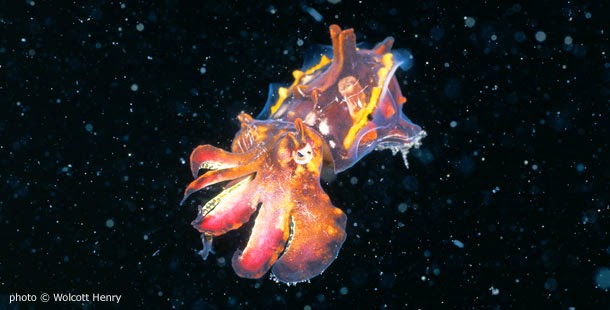Abiotic and Biotic Interactions: Sunlight affects the amount of algae growth. Plants underwater take in carbon dioxide and release oxygen.
 Producers: Phytoplankton and aquatic plants (seaweed and algae)- Every species in the marine biome need organic carbon to survive and these tiny organisms produce it. Phytoplankton make their own energy by using photosynthesis.
Producers: Phytoplankton and aquatic plants (seaweed and algae)- Every species in the marine biome need organic carbon to survive and these tiny organisms produce it. Phytoplankton make their own energy by using photosynthesis.
There are 5 different zones to the Marine Pelagic Biome:
Epipelagic Zone (First 500 ft below the surface)- Sunlight Zone
This zone has only cyanobacteria and phytoplankton in it. It receives enough light for the tiny organisms to go through photosynthesis. At night, zooplankton rise toward the surface to feed on algae and bacteria. Most predators, both invertebrate (copepods) and vertebrate (fish) feed at night. The carnivores hunt by sight, so because of natural selection, zooplankton are transparent. Fish that come up to eat are dark on top and light on their bellies so predators don't come up and eat them. Many marine animals come up here, from plankton to great blue whales.
Blue Marlin Photo by Tony Arruza/Corbis
Mesopelagic Zone (660-3,300 ft)- Twilight Zone
The temperature varies from 68 F- 39 F based on what part of the world you are at. This zone is known as the twilight zone because it does not have enough sunlight for photosynthesis. Fish in this zone have light producing organs and gas filled bladders to help them control buoyancy. Predators have upward-oriented eyes and mouths. Examples of animals in this zone: swordfish, squid, eels, cuttlefish
Cuttlefish Photo by Wolcott Henry
Bathypelagic Zone (3,000-8,000 ft)- Midnight Zone
The average temperature is 39 F. This zone has the highest diversity of organisms. Fish here are black and have an antennae to help with buoyancy. Bioluminescence is important for species and gender recognition, luring prey, and confusing predators. There are no plants because there is no sunlight.
Organisms in this zone: Viperfish, frill shark, squid, whales, octopus
Abyssopelagic Zone (13,123 to 19,685 ft)- Bottomless Abyss
This area has immense pressure and constant cold (35-37 F) Animals here are able to withstand the pressure (black swallower, deep-sea anglerfish and the giant squid) Some of these creatures have underslung jaws to sift through the sand to catch food.
Deep Sea Anglerfish from Disney's Pixar "Finding Nemo"
Hadopelagic Zone (20,000 ft to the bottom of the ocean)- Hades/Greek Underworld
This zone has low population and low diversity of marine life. The most common organisms here: jellyfish, viperfish, tube worms, and sea cucumbers.
Viperfish Photo by Danté Fenolio
These zones all work together because the animals eat the other animals in the zone above them. It is a circle of life.
 Producers: Phytoplankton and aquatic plants (seaweed and algae)- Every species in the marine biome need organic carbon to survive and these tiny organisms produce it. Phytoplankton make their own energy by using photosynthesis.
Producers: Phytoplankton and aquatic plants (seaweed and algae)- Every species in the marine biome need organic carbon to survive and these tiny organisms produce it. Phytoplankton make their own energy by using photosynthesis.
Consumers:
Herbivores- Zooplankton- eat the phytoplankton and invertebrates (like sea urchins) and other fish eat seaweed.
Carnivores- Small carnivores (like sardines) eat herbivores (like zooplankton), but serve as a meal for bigger animals; Top predators (like sharks, tuna, seals and birds) eat the small carnivores.
Decomposers: Hagfish, worms, fungi and bacteria






No comments:
Post a Comment